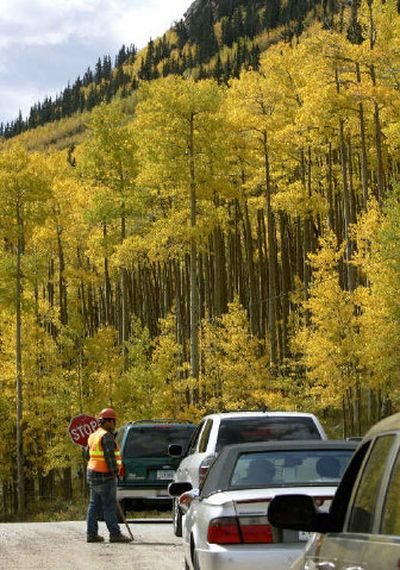No leaf unturned

GEORGETOWN, Colo. — Tourists head for the peaks above this historic mining town to see autumn leaves of gold and orange that turn a bit bolder each day amid the forest of thick, green pine.
For Vicky Speigelmyer at the Santa Fe Trail shop and other merchants, it’s a welcome sight since business typically drops after fall school sessions begin.
“People love to watch the aspens turn,” she says.
Leaf peeping, a nickname given to the tradition of viewing fall foliage, generates hundreds of millions of dollars every year from Maine to Washington as tourists visit forests and surrounding towns, staying anywhere from a few short days to weeks.
“It’s a phenomenon, and it has really taken hold in the industry,” Travel Industry Association of America spokeswoman Cathy Keefe said. “It really brings people into some of the smaller areas, the rural areas that are not like first-tier destinations.”
With rising gas prices and events related to the aftermath of Hurricane Katrina, Keefe is expecting a flat fall travel season overall after a record of 278 million trips was set in 2004.
“We’ll still see people taking in leaf foliage and the changing seasons,” she said. “We’ll still see people taking long weekends but I don’t think we’re going to see big growth.
“If we remain stable this fall, that’s not necessarily a bad thing. You’re still talking the highest numbers we’ve ever seen,” Keefe said.
AAA spokesman Justin McNaull does not expect high gas prices to dampen fall foliage trips because most people typically travel short distances which he said wouldn’t be that much of a budget-breaking venture.
The travel industry began promoting fall foliage trips to boost business in the shoulder season between summer and winter. Although it began primarily with afternoon drives, the popularity has many Americans planning longer trips, staying at hotels and visiting shops, service stations and restaurants.
Sites are accessible in just about every way imaginable — cars, buses, trains, horses, cruise ships, bicycles and on foot.
Today, fall travel accounts for about 25 percent of all travel, up from about 22 percent some 13 years ago, Keefe said, adding that some of the increase can be credited to leaf-viewing trips. In comparison, summer accounts for about 33 percent of all travel.
Gloria Singleton, a travel agent with the Internet Travel Center, said she has seen the number of fall foliage tours grow by 50 percent in the past decade, noting that it is difficult to find available space on them this time of year.
Tour packages, from bed and breakfasts up to multi-day trips, are becoming more popular, said McNaull of the American Automobile Association.
Among popular leaf-peeping sites are the Northeast, the Shenandoah Valley, the Blue Ridge Parkway through Virginia and North Carolina, the Rockies and routes through Midwestern and Western states, travel industry officials say.
In heavily forested New Hampshire, tourist officials are expecting a 1 percent increase in fall tourists, putting the total at 7.7 million who likely will spend about $1.04 billion during the season.
In nearby Vermont, about $337 million in spending is generated during the 30-day fall foliage season, said Cathy Herlihy, a deputy commissioner with the Vermont tourism division.
“Most people drive around, look at the leaves, do some shopping, have a nice lunch, stay at a nice bed and breakfast. It really is a low-stress vacation — even when it’s busy here we don’t have traffic. What’s not to like?” she asked.
In Colorado, the brilliant golden colors of the aspen trees can be seen across the Rockies, from Durango and the Maroon Bells area near Aspen to the Peak-to-Peak Scenic and Historic Byway from Black Hawk to Estes Park west of Denver.